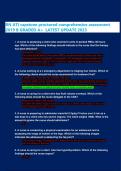Summary
Summary Past Present Future of Facility Design.docx HCS 529: Past, Present and Future of Facility Design The University of Phoenix HCS 529: Contemporary Health Care Facility Design Past, Present and Future of Facility Design Health care facility design is
- Course
- University Of Phoenix UoP
- Institution
- University Of Phoenix
Past Present Future of Facility D HCS 529: Past, Present and Future of Facility Design The University of Phoenix HCS 529: Contemporary Health Care Facility Design Past, Present and Future of Facility Design Health care facility design is something that has evolved over the years from physic...
[Show more]












